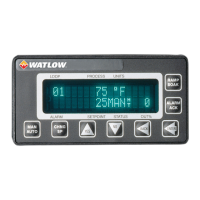CLS200 Series User’s Guide
176
N
NO-Key Reset
A method for resetting the controller’s memory.
Noise
Unwanted electrical signals that may produce
signal interference in sensors and sensor
circuits. See also Electromagnetic Interference.
Noise Suppression
The use of components to reduce electrical
interference that is caused by making or
breaking electrical contact, or by inductors.
Nonlinear
A firmware feature that reduces the actual
output signal from the automatically calculated
level. Often used with cool outputs.
O
Offset
The difference in temperature between the
setpoint and the actual process temperature.
Offset is the error in the process variable that is
typical of proportional-only control.
On/Off Control
A method of control that turns the output full on
until setpoint is reached, and then off until the
process error exceeds the hysteresis.
Open Loop
A control system with no sensory feedback.
Operator Menus
The menus accessible from the front panel of a
controller. These menus allow operators to set
or change various control actions or features.
Optical Isolation
Two electronic networks that are connected
through an LED (Light Emitting Diode) and a
photoelectric receiver. There is no electrical
continuity between the two networks.
Output
Control signal action in response to the
difference between setpoint and process
variable.
Output Type
The form of PID control output, such as time
proportioning, distributed zero crossing, Serial
DAC or analog. Also the description of the
electrical hardware that makes up the output.
Overshoot
The amount by which a process variable
exceeds the setpoint before it stabilizes.
P
Panel Lock
A feature that prevents operation of the front
panel by unauthorized people.
PID
Proportional, Integral, Derivative. A control
status with three functions: Proportional action
dampens the system response, integral corrects
for droops, and derivative prevents overshoot
and undershoot.
Polarity
The electrical quality of having two opposite
poles, one positive and one negative. Polarity
determines the direction in which a current
tends to flow.
Process Variable (PV)
The parameter that is controlled or measured.
Typical examples are temperature, relative
humidity, pressure, flow, fluid level, events, etc.
The high process variable is the highest value
of the process range, expressed in engineering
units. The low process variable is the lowest
value of the process range.
Proportional (P)
Output effort proportional to the error from
setpoint. For example, if the proportional band is
20° and the process is 10° below the setpoint,
the heat proportioned effort is 50%. The lower
the PB value, the higher the gain.
Proportional Band (PB)
A range in which the proportioning function of
the control is active. Expressed in units, degrees
or percent of span. See also PID.

